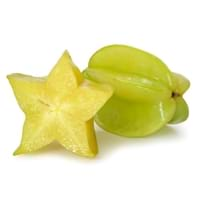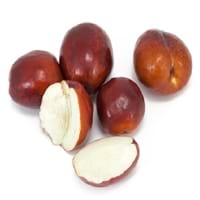Health Benefits
Cancer prevention, Heat stroke treatment
Cancer prevention, Diarrhea treatment, Improves muscular strength, Liver health, Maintains hormonal balance, Reduces nervous tension, Reduces blood circulation problems, Reduces stress, Regulation of heart rate, Treatment of hysteria
General Benefits
Anti oxidant properties, Anti-inflammatory properties, Digestive aid, Maintains healthy cholesterol level, Treatment of sore eyes
Anti oxidant properties, Digestive aid, Flu treatment, Helps in weight loss, Strengthens bones, Treatment of common cold
Skin Benefits
Anti-aging benefits, Heals sunburn, Skin rejuvenation
Heals sunburn, Hydrates skin, Reduces wrinkles, Skin rejuvenation, Skin revitalization
Hair Benefits
Promotes longer and healthier hair, Protects hair
Promotes longer and healthier hair, Protects hair
Allergy Symptoms
NA
Abdominal pains, Breathing difficulty, Diarrhea, Hives, Itching in eyes, Itching of nose, Nasal congestion, Redness of eyes, Runny nose, Sneezing, Wheezing
Side Effects
Nausea, Vomiting
Decrease in blood sugar levels, Intense headache
Lactating Women
Yes
Not Available
Best Time to Eat
As a snack in the late afternoon, Eat the fresh ones, avoid mixing with any other foods, don't eat after meal., Strictly avoid empty stomach
As a snack in the late afternoon, Don't consume at night and before bed, Morning time (before lunch), Strictly avoid empty stomach
Vitamin B5 (Pantothenic Acid)
Not Available
Vitamin B9 (Folic acid)
Not Available
Vitamin C (Ascorbic Acid)
Vitamin E (Tocopherole)
Not Available
Vitamin K (Phyllochinone)
Not Available
Lutein+Zeaxanthin
Not Available
Calories in Fresh Fruit with Peel
Calories in Fresh Fruit without Peel
Not Available
Not Available
Calories in Frozen Form
Not Available
Not Available
Calories in Canned Form
Not Available
Not Available
Calories in Juice
Not Available
Type
Tree fruit
Tree fruit
Season
Autumn, Spring, Summer
Autumn, Summer
Varieties
King, Bell, Sri Kembangan, Arkin and Fwang Tung
Honey Jar, Sugar Cane, Li, Shanxi Li, Sherwood, Chico, Silverhill, Tigertooth, Winter Delight and Lang
Color
Golden yellow, Green
Green, Red, Yellow
Inside Color
Yellowish Green
White
Shape
Oval and Star(Cross section)
Round
Taste
Crisp, Juicy, Sweet
Sweet
Grows on
Not Available
Trees
Soil Type
Loam, Well-drained
Sandy, Well-drained
Climatic Conditions
Moist, Warm to hot climate
Warm to hot climate
Facts about
- When carambola is cut horizontally, it forms a star.
- It is believed that carambola helps to cure hangover.
- Entire carambola is edible, including its skin.
- 2 varieties of carambola are cultivated: tart & sweet.
- Pigment extracted from Indian jujube is used for silk dyeing in Burma.
- In Korea, jujube wood is used to make wind instrument taepyeongso.
- Fresh jujube is known as Chinese apple & dried form is called as Chinese date.
Top Producer
Taiwan
China
Other Countries
Australia, Guyana, India, Israel, Malaysia, Philippines, United States of America
Bangladesh, India, Iran, Korea, Lebanon, Pakistan
Top Importer
Europe
United States of America
Top Exporter
Malaysia
China
Botanical Name
Averrhoa carambola
Ziziphus zizyphus
Synonym
Not Available
Ziziphus jujuba or Ziziphus mauritania or Zizyphus jujuba
Subkingdom
Tracheobionta
Tracheobionta
Division
Magnoliophyta
Magnoliophyta
Class
Magnoliopsida
Magnoliopsida
Family
Oxalidaceae
Rhamnaceae
Species
A. carambola
Z. zizyphus
Generic Group
Not Available
Not Available
Difference Between Carambola and Jujube
We might think that Carambola and Jujube are similar with respect to nutritional value and health benefits. But the nutrient content of both fruits is different. Carambola and Jujube Facts such as their taste, shape, color, and size are also distinct. The difference between Carambola and Jujube is explained here.
The amount of calories in 100 gm of fresh Carambola and Jujube with peel is 31.00 kcal and 79.00 kcal and the amount of calories without peel is Not Available and Not Available respectively. Thus, Carambola and Jujube belong to and category.These fruits might or might not differ with respect to their scientific classification. The order of Carambola and Jujube is Oxalidales and Rosales respectively. Carambola belongs to Oxalidaceae family and Jujube belongs to Rhamnaceae family. Carambola belongs to Averrhoa genus of A. carambola species and Jujube belongs to Ziziphus genus of Z. zizyphus species. Beings plants, both fruits belong to Plantae Kingdom.









